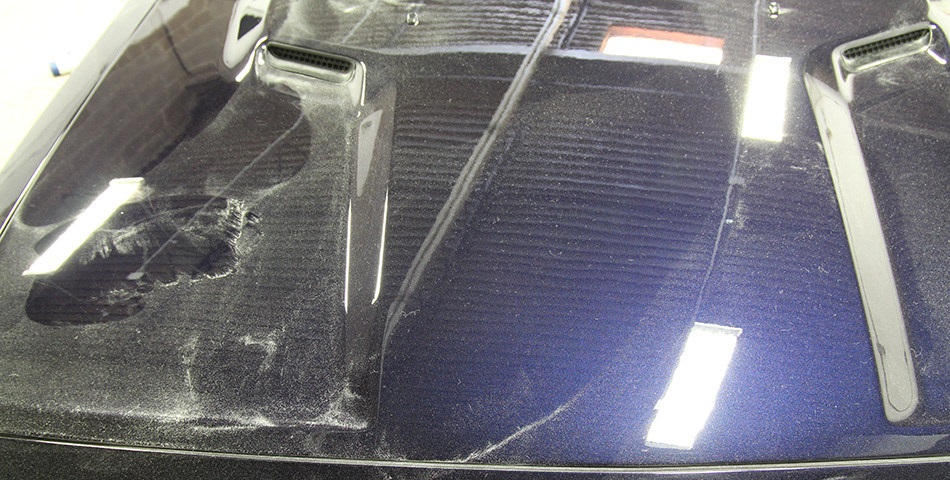We’ve all seen it, especially when working with some aggressive compounds and polishes, such as Meguiar’s 105, Menzerna Power Gloss and Poorboy’s SSR3. All three of these are polishes meant for some fairly serious swirl mark removal, so they tend to be abrasive and leave quite a bit of dust behind. We tend to use a lot of Meguiar’s 105 paired with a Lake Country Purple Foamed Wool Pad with the Flex 3401 polisher.
After only a couple sections of polishing, this is what the car starts to look like…
Unfortunately, most of the time, it’s just the nature of the beast. The dust comes from the actual polish, the paint being removed and also some of it is simply the fibers of the wool pad coming off. The photos above show dust that’s typically found after using a wool pad. Foam pads don’t normally leave this much dust. Reason being, foam pads are enclosed in a way and contain the dusting both by keeping the polish and paint residue on the surface of the pad, but also by absorbing some of the polish both initially and also once it starts dusting. Wool pads on the other hand are more “open” and the fibers go in all directions without much containment, so the dust coming from under it is more likely to escape.
There aren’t many ways to avoid dust because it simply has to go somewhere. It comes from the polish breaking down (polish basically turns from liquid to dust or abrasive particles as the lubricating oils dry up during the polishing cycle) and also from the paint being removed. The dust coming from the paint is something that surely can’t be avoided as that is the purpose of the whole process in the first place. This is most noticeable when working on paint that is a single stage, meaning no clear coat. What happens is the pads will start showing the color of the car and the dust all around the vehicle will be a certain color. I will try to get a photo soon of an upcoming red Supra we will be working on, but I believe there is an existing article on here showing exactly what I’m talking about here. First to find it gets a prize :).
In any case, the dust from polishing is what can be reduced to an extent and will surely help with the cleanup process and prep for the next polishing stages. As mentioned above, one way to reduce dust is by avoiding wool pads. However, this should be done only in the case that the results provided by a foam pad are the same or better as that of a wool pad. I would much rather have to clean up more dust after while getting great results from only one stage of polishing with a wool pad, instead of little dust cleanup after having to do two stages with a foam pad. Hope that makes sense. Another way to reduce dust would be to experiment with the polishing cycles of different products. The longer you work with a polish, the more it tends to dust, so if you are able to get the same results from 30 seconds of polishing and 45 seconds of polishing an area, go for 30 seconds as there will be less dust to clean up. Lastly, there are products such as the Chemical Guys Polishing Pad Conditioner, which help reduce the dusting a bit by making the pads more damp. I’m not the biggest fan of these as I like to just use the polish and make sure I can get the most of it without any interference, but it should help.
Hopefully some of this sheds a bit of light on the subject and I’d love to hear any tips from the other authors as well as readers!
